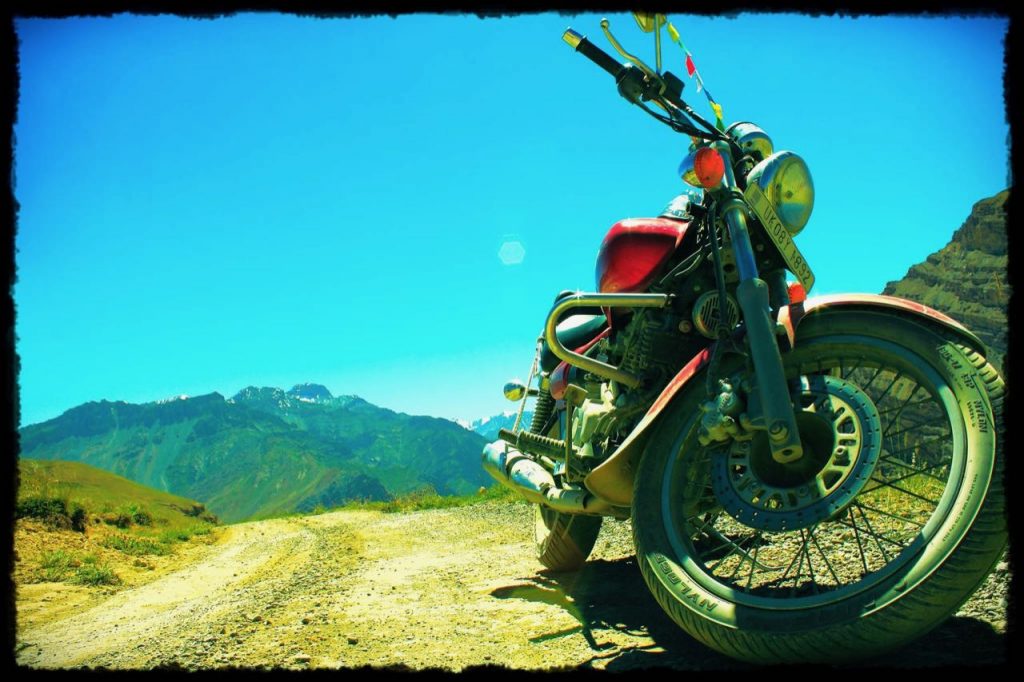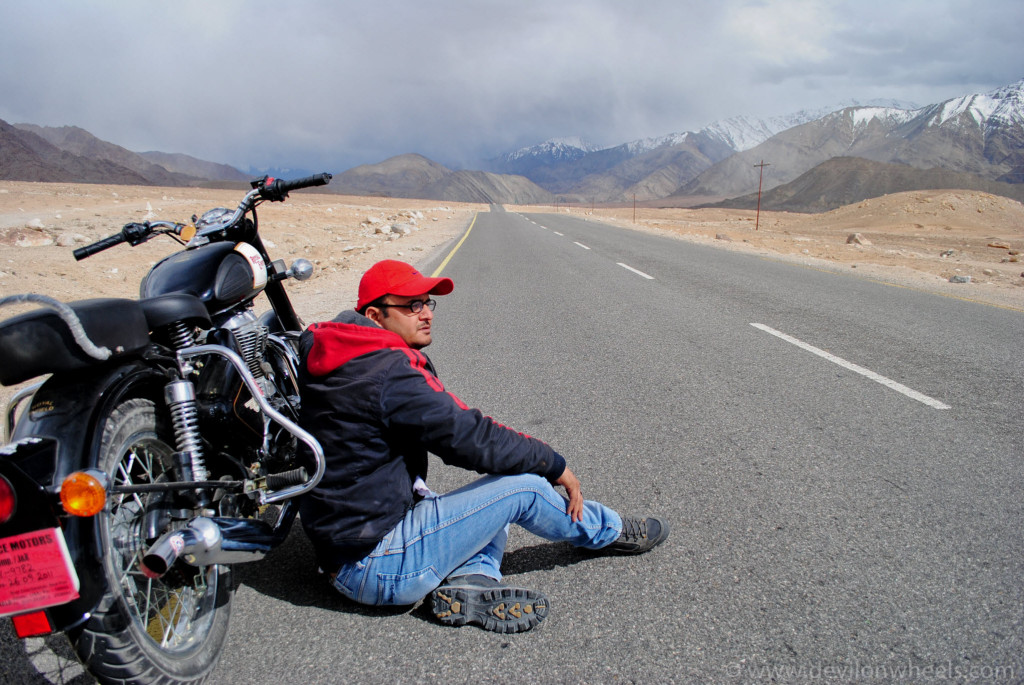Long Distance Motorcycle Trips- the epitome of all great adventures! If you’re anything like me, you’ve spent many days daydreaming of being out on the road, enjoying the thrill of the wind in your hair, and your entire life in a backpack.
Let's quickly dive into the details:
Most Important Tips for Long Motorcycle or Bike Ride Trip in the Himalayas
But, there’s a lot more practicality that goes into accomplishing this meant feat! Riding for long distances is not just fun and joy, the daily grind can truly get to you, especially if you’re not mentally prepared!
So, I bring to you the most complete travel advice for long-distance motorcycle riding!
1. Know your limits
If the longest journey you’ve ever done is 250 KMs, then you should not be planning to do 500+ KMs per day for multiple days! Don’t push yourself that hard; it will ultimately take a toll on your body and mental health. It is wise to scale up your daily travel capacity gradually and never push yourself too hard!

2. Be well prepared
The majority of your journey can be smooth if you plan. If you can’t get your bike right before you start your trip, the road is no place to be making repairs or hoping for the best. Ideally, you should have your bike completely checked before you start on your journey to ensure everything is functioning as it should be.
But, be careful that you are not modifying (adding accessories, making big repairs, etc.) your bike immediately preceding your bike trip! You should, however, meet a local mechanic who can adjust the padding inside your seat to give you optimum height and comfort level.
Also, remember that your helmet is your best friend. Any time is the best time to get a helmet that fits you perfectly, and there should be no glitches in that. Also, do ensure you have a new scratch-free visor on the helmet.
While it might be the peak of summer with no signs of weather fluctuations, it is still wise to keep your rain gear ready. A complete rain suit plus shoes are essential on long rides. Have a large plastic cover for your luggage as well.
Being dry is the key to a worthy journey. If you (or your staff) get soaking wet – the chances are high that you’ll get sick and unable to carry on. Never fun to go off schedule for sickness.
When you’re packing, do remember to carry packets of mixed dry fruits with you, and consume daily while riding for energy.
Prepare your first aid kit wisely and secure it to the bike in a way that makes it easily accessible. Apart from the standard first-aid kit, you should also have a torch, wet wipes, toilet roll, map/itinerary, photochromatic eye-wear in case it gets dark while riding and eye drops.
Lastly, do have a checklist for your travels along with a physical address book and if possible, a spare mobile phone.
3. Safety is the key when long-distance motorcycle riding
When you’re in the game of long-distance motorcycle riding, you’re truly in a marathon and not a sprint. So, forget about speeding through the heavily packed city streets. Slow and steady truly wins the race! Do not think a cuppa coffee or a Redbull will get you far – don’t touch that thing. If you’re tired, the best thing to do is stop!
Small efforts will make the biggest difference in your overall experience. If it looks and feels like it might start raining – get into your rain suit now, don’t wait for it to start raining before you do!
If your tank has only 25% gas remaining – fuel up now. When you spot a long haul truck up ahead, it is wisest to maintain distance! Even if the road seems smooth, resist the temptation of flying past to make up for the lost time.
Long-distance motorcycle riding is not rocket science. Use your common sense and know what can and cannot hurt you. Don’t take unnecessary risks.

4. The support system on a long-distance motorcycle trip – Your Riding Gear Kit
Especially for a motorcycle long distance trip – it is crucial to pack wisely. Less is more has never been truer than in the case of long-distance travel on a motorcycle. Access to things becomes vital as well in this game (flashlights, eyeglasses, etc.). You should keep these things within reach and minimal effort.
Also, you must carry a flat-repair kit with you, and you should have enough expertise to repair a flat when it comes to that! Also, you should be wise and carry extra clutch wires and spark plugs. Along with this, you can even carry a foot pump if the journey is through isolated areas. The most important thing to keep with you is some m-seal.
First things first, DO NOT ride without protective gear on. Trust me on this; it makes a hell lot of difference if you do fall! Protective gear will also give you a confidence boost when you’re riding.
5. Know when to rest
The easiest indication of after how long you should stop – is listening to your body. If your back starts aching (and it will!) – take a breather, pull over. Stretch yourself out and drink some water. Move around a bit, take some pictures, and relax.
Indeed, it is true that small breaks to cut the monotony of riding along will eventually speed you up with a fresher mind and body. As a thumb rule, it is healthy to take a break every hour or so for at least 10 minutes. This rule, you can customize as per what your body is telling you!

6. Be health-conscious
Road trips are often accompanied by minimal food choices. Whatever you can get at the next dhaba or a road-side stall is often your only meal. If you cannot manage to eat healthy (think of all the Maggi you will consume during your long-distance biking trip!), at least eat light.
Heavy meals can lead to a bunch of issues – from indigestion to sleepiness to puking and worse! If you’re unsure of the food you’re consuming – stick to the classics of bread, butter, toast, omelets, etc.
Another advice that often goes unheard – yet is the most important – stay hydrated! When you’re amid a long-distance biking adventure – you must drink at least 2 liters of water a day. Dehydration will amplify the effects of high altitude sickness, tiredness, aches, and cramps will get more severe.
Keep drinking a little regularly rather than drinking lots of water in one go. Add ORS (not glucose) to the water to replenish salts and minerals, if necessary.
Also, whenever you do take a break, keep splashing your eyes with water. It will liven you up in a heartbeat. Personally, I enjoy washing my face with ice-cold water to get the circulation going (especially in the hills, you can stop by any river – the water will be cold!).
I would suggest that you add a supplement of vitamins to your daily diet. Check with your doctor before taking anything, however.
In case of headaches, try not to take any heavy medicines, Disprin is best to control headaches. You may take heavy meds once you reach your destination and can get ample rest. If you’re traveling to high altitude regions, Diamox is a tried and tested medicine for AMS. Do check with your doctor for suitability.
7. Be aware of your surroundings
It is essential, especially for a country like India, that you are alert and vigilant at all times. It doesn’t take long for a nice two-lane road to quickly become a road of potholes within a few short minutes. The bumpy rides can be a mess to you physically and exhausting for you emotionally!
So, you must keep in mind that your smooth-as-butter roads will not be there with you at all times. Also, if you’re undertaking this endeavor in the Himalayas, you’ll not only have to be careful about the condition of the roads but also oncoming traffic.
Also, coupled with the sharp bends and the general public not quite following the driving rules can lead to unfortunate circumstances. It is always wise to be careful!

8. Maintain your posture – Take care of your body
When you’re riding long distances, your body will feel it. It is important to take regular breaks. But, do remember that backaches are a natural part of this life – especially if your riding posture is compromised. This fact might be even truer if you’re not a regular rider!
To circumvent this, the best option is to ride light and wear a nice jacket with spine support. Yes, it might get hot in the scorching Indian summers, but it will be God-sent for back support. Also, Don’t tie anything on your body. No backpacks, no cameras, and no pouches on the waist!
You should strive to keep your back, waist & shoulders free and light. Another thing you can do to ensure back support has a bag tied on the pillion seat as it helps in avoiding back pain by providing support. If tying a bag on the pillion is not an option, you can use a waist best as well. It will keep your back erect! Still, your butt will hurt – no matter what you do. so be prepared for that 🙂
This is often neglected, but remember that you shouldn’t expose your hands if you intend to ride at large in one go. Cover hands with gloves, or else your hands might swell up!
Challenges in long-distance motorcycle riding
Even if you prepare well and do everything that is needed, you will still face certain issues. One of the biggest problems that will come your way is water wetting the foot. You may get help with backache; wet shoes won’t be.
You require a good pair of shoes (remember grip trumps waterproof shoes) and LOTS of socks. You can try and cover your shoes with plastic bags, etc., but this still won’t ensure full dryness. Just remember to carry a spare for shoes and dry your feet as soon as possible when you unavoidably get some water into your shoes!
Lastly, the wind is a major disadvantage for bikers as it hits your head and eyes. The helmet helps but sunglasses will make more sense.

Other Articles in Spiti – Ladakh Bike Ride Series
- Preparing your bike for Ladakh or Spiti trip
- Packing List for long-distance motorcycle riding
- Safely Carrying Spare Fuel & Luggage on Motorcycle
- Tips for Cold Weather Motorcycle Ride in Ladakh or Spiti
- Clothes & Accessories to Carry on Ladakh Bike Ride
- Tips for Tackling Water Crossings on Ladakh – Spiti Bike Ride
Conclusion
The most alluring of adventures – long-distance motorcycle riding is an art. This art, however, requires you to plan well and be aware of what your body is trying to tell you. It is always better to be safe than sorry.
Have a travel question?? You can subscribe to my YouTube channel and leave a comment to ask your travel questions about traveling to the Himalayas.
So, do follow some of the evergreen rules passed through the wisdom of fellow travelers. Happy and safe travels to you!
Don’t worry much. Enjoy your ride. Whenever you feel tired take a break and you will be fine!





![Why avoid traveling on Manali Leh Highway in October for Ladakh trip? [5 Safety Reasons]](https://discoverwithdheeraj.com/yt_vid_thumbs/ladakh/104.png)